Samsung Galaxy S 4 Review - Part 1
by Brian Klug on April 24, 2013 12:01 AM ESTDisplay
We wrote about how we suspected that SGS4 would go to a 5-inch 1080p SAMOLED display just after CES. Turns out that was spot on, as the SGS4 includes a 5-inch 1080p Full HD SAMOLED panel, the latest in Samsung's AMOLED roadmap. Samsung's naming stays true, and there's no Plus tacked on at the end, so we get another non-RGB stripe subpixel geometry with SGS4. The last few Samsung AMOLED variants we've seen have had different subpixel grids, and the one on the SGS4 is possibly the most interesting to date. There's still a bias toward more green subpixels than blue or red, this isn't an RGB stripe at all, but instead of the previous RG,BG layout we see this offset pattern with green on one line, then blue and red on another line. Interestingly enough the blue subpixel appears to be a square, and red and green appear to be circles, with the difference in area possibly offsetting the luminous efficiency of each material. Whatever the reason (Samsung has never been official or forthcoming any of these subpixel patterns each time they've changed them) it's present on the SGS4.
At this size however I have to admit that I find the pursuit of the subpixel geometry more of an educational one than something which affects users. While I could occasionally see it on the SGS3, I definitely do not see it on SGS4. The subpixels are now small enough that whatever the pattern, it all looks like a homogenous light-emitting surface, which was the goal after all. I could bring up the visual acuity discussion again but just trust me that it's small enough to not be visible even with actually perfect (not legally perfect, which is different) vision.
So resolution is great and up to par with all the other LCD-bearing flagships this year, lack of RGB stripe notwithstanding. There's that remaining question about brightness, contrast, outdoor visibility, and of course calibration and the saturation issue that has persisted with AMOLED from generation to generation.
On the brightness front, the SGS4 includes dynamic contrast functions that cannot be disabled and change as a function of what is being displayed. There's an "auto adjust screen tone" checkbox under display but don't let that fool you, that doesn't disable dynamic contrast, just white point. Under screen mode are the mDNIe toggles we've seen on countless other previous Samsung Android phones with AMOLED panels, only here we notice something interesting. There have always been four toggles as long as this option has existed, only what's different is now, one of them is named "Professional photo." Reviews of other regional variants of the SGS4 have included the same button but marked "Adobe RGB." Oddly enough it seems that the North American versions at least have this renamed for some reason, but undoubtedly the function is the same. Many speculated that this is now a toggle for some full CMS (Color Management System) which "fixes" the inherent color space issues with AMOLED and oversaturation that occurs when looking at sRGB content on such devices. Unfortunately, I can confirm that my initial suspicions that this is just a continuation of the mDNIe (lite) settings from previous generation is in fact correct. I reverse engineered what I could of these settings from both kernel messages while changing the toggles, and looking at the kernel sources. Turns out that 'Professional photo' mode is actually the 'Natural' mode renamed from previous versions.
So the question was whether the color space or white point actually does change with this mode enabled. I ran the SGS4 through our display tests in each of the modes and think the full color space plot tells the story. The sanest of them all really ends up being the strangely-named 'Movie' mode. Professional photo gives the big gamut with a white point closer to 'Movie,' which is to say around 7000K, but it doesn't fundamentally change the still-present oversaturation or color management issue that exists in Android with these wide gamut displays. Most users admittedly don't care however and just see "bright" colors. Theres' an Auto mode as well which the device ships with that basically has a matrix of mDNIe settings for targeted applications (for example the Gallery, Browser, Video playback) and so forth get settings, which you can see in the kernel.
| CalMAN Display Comparison | ||||||||||||
| Metric | iPhone 5 | iPhone 4S | HTC One X | SGS3 | Samsung Galaxy Note 2 | Google Nexus 4 | HTC Droid DNA | HTC One | SGS4 | |||
| Grayscale 200nits Avg dE2000 | 3.564 | 6.162 | 6.609 | 4.578 | 5.867 | 7.686 | 6.738 | 5.391 | 7.511 | |||
| CCT Avg (K) | 6925 | 7171 | 5944 | 6809 | 7109 | 8506 | 8108 | 8118 | 7020 | |||
| Saturation Sweep Avg dE2000 | 3.591 | 8.787 | 5.066 | 5.460 | 7.986 | 8.517 | 5.856 | 3.365 | 7.823 | |||
| GMB ColorChecker Avg dE2000 | 4.747 | 6.328 | 6.963 | 7.322 | 8.185 | 7.531 | 6.687 | 4.656 | 7.440 | |||
In the "Movie" mode things are better controlled than the Note 2 on the GMB color checker card test, which is the most important one for me. White point is also no longer the crazy 8000K that we saw before, 7000K is commendable for Samsung at this point. Keep in mind that maximum brightness changes in each mode as well as we effectively clamp things, I measured a maximum of 319 nits in Dynamic mode, 311 nits in Movie mode, and 255 nits in Standard, for example.
Running the display at maximum brightness for too long will also get you into an overheating or thermal protection mode as well, which we've seen on countless other AMOLED variants. Most of the time I suspect users will run on Auto brightness however which keeps brightness down to a much lower level to save battery and prevent that from becoming a problem.
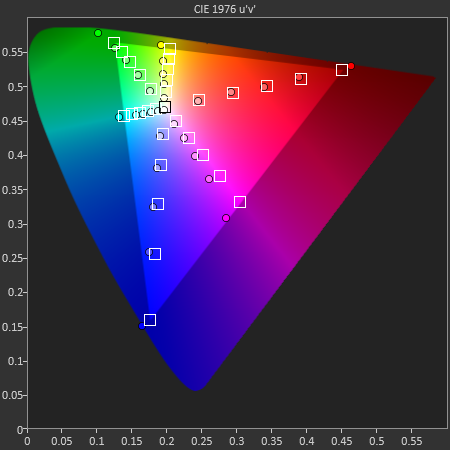
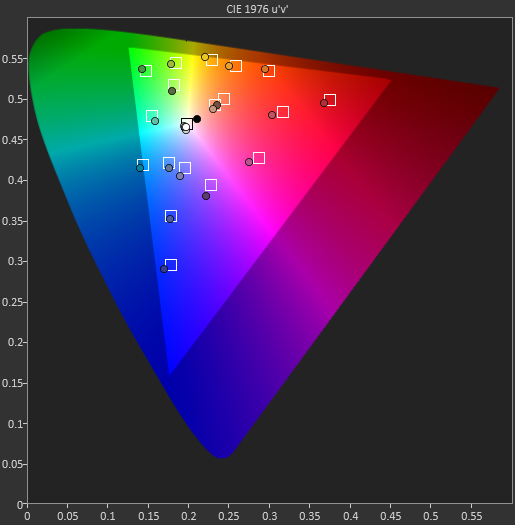
Because "Movie" was the closest to sRGB of all the modes, I selected it for the actual results that I'll present in the table. Admittedly this mode does tighten things up a bit, but it still isn't perfect and I'd still like to see Samsung do something to reign this in at some point.


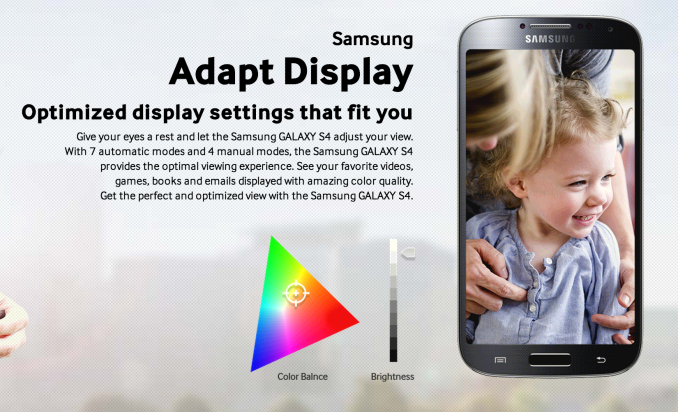




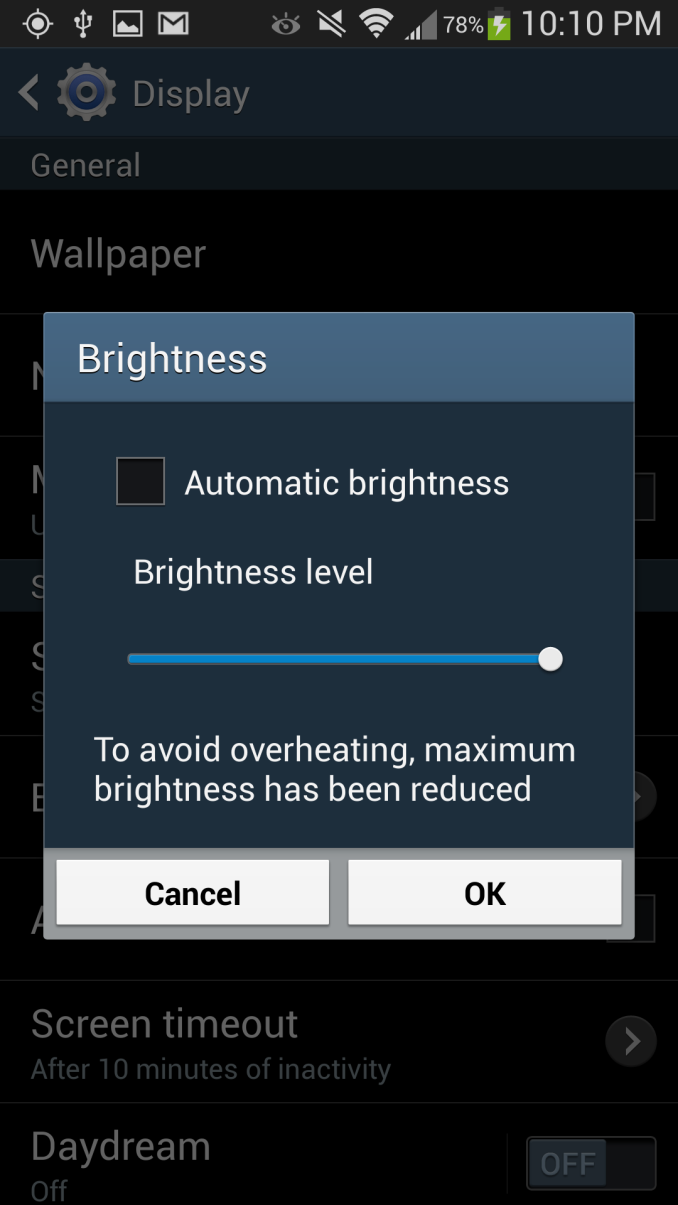
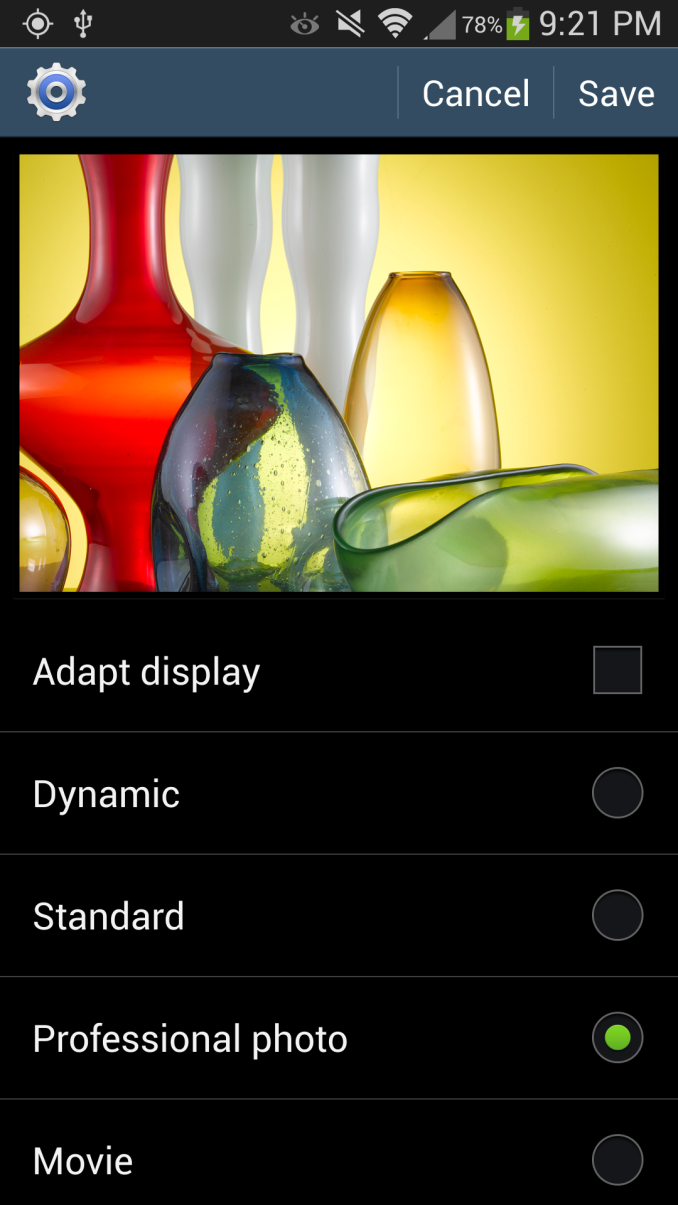
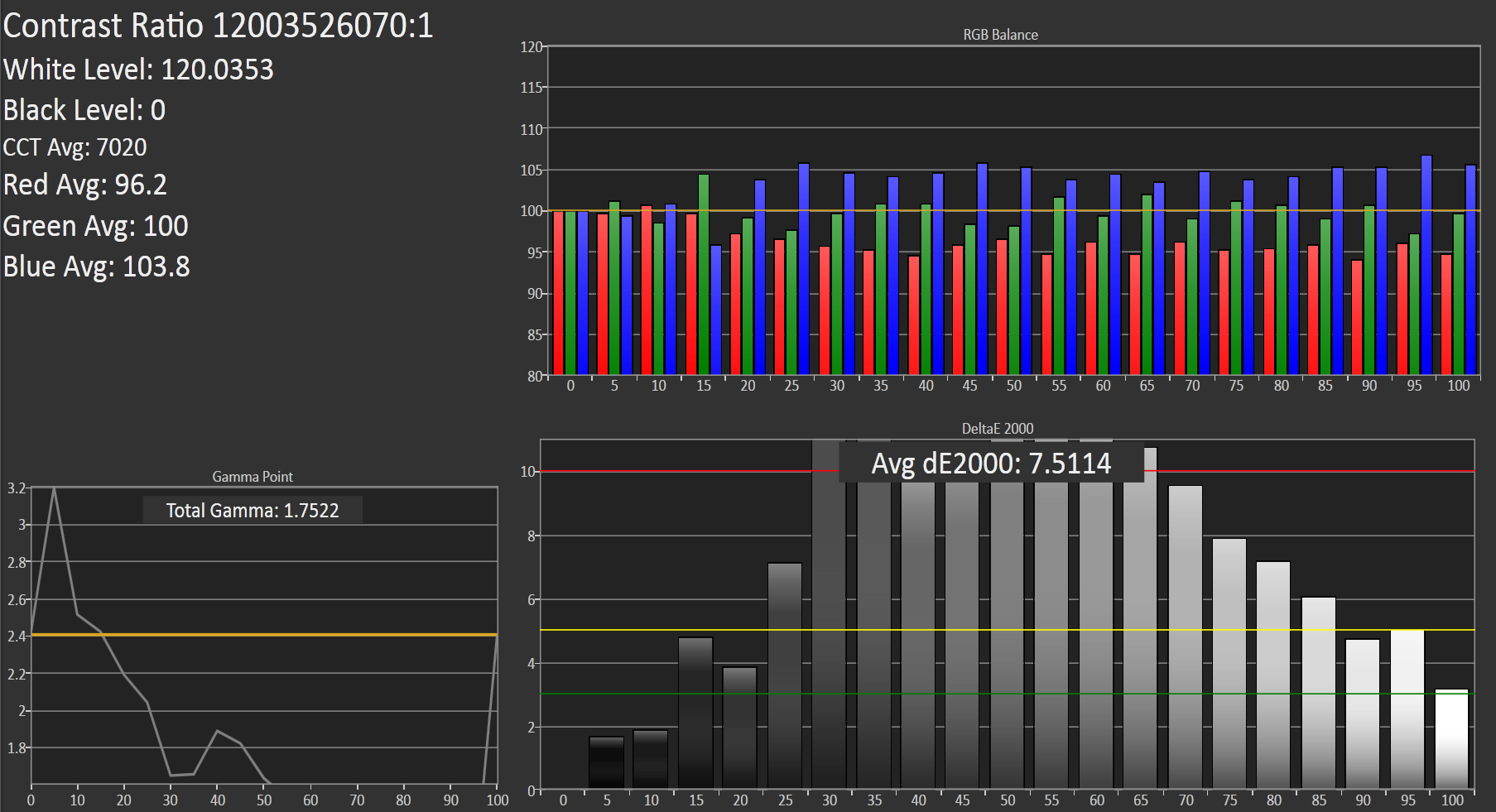








335 Comments
View All Comments
Exodite - Wednesday, April 24, 2013 - link
The screen I'd imagine.The iPhone 5 has a screen that's ~65% the size, and ~35% of the resolution, of the one used by the Galaxy S4.
Its not the only reason of course but the screen matters a lot.
gnx - Wednesday, April 24, 2013 - link
Also a weakness of AMOLED. Since it needs to lighten up all subpixels max to get to white (and turns off all subpixels for gorgeous black). So web browsing, with so most sites having white background, really cranks up the power consumption of the display, hence the unexpectedly shorter battery life compared to other scenarios.sigmatau - Thursday, April 25, 2013 - link
I have a Nokia 900 with a Samsung sourced AMOLED plus which is beyond terrible outside on full brightness. I wonder how this one compares.lopri - Wednesday, April 24, 2013 - link
In that chart, iPhone 4S is leading Nexus 4. I have both and I call that bogus. Not sure what kind of iPhone 4S they've got.kmmatney - Wednesday, April 24, 2013 - link
We have mostly iPhones at my work, but a few SG3s. It's pretty easy to compare the real-use battery life at a conference, where we have to be on battery all day, and use are phones for normal stuff like email, texts, some web browsing, etc.. Without fail, the iPhones are all still going strong at the end of the day, while the SG3s have dead batteries. I was hoping the SGS4 would fix this, but I can't tell from the review. I hope the Note 3 increases the battery life.RealityMonster - Monday, April 29, 2013 - link
Apple has consistently refused to put tech in their phones unless they can still get 10hrs of battery life out of it. That's why the iPhone 5 is the first one to have LTE--the 4s just couldn't keep a charge long enough. Part of it is the form-factor, since a smaller phone means a smaller battery. Like other people have mentioned, though, the smaller screen is also a smaller power draw.So while you're never likely to see an iPhone that has a substantially better battery life than 10hrs under browsing conditions, you'll never see one that has a substantially lower life, either.
Gorgenapper - Tuesday, May 14, 2013 - link
That's a nice thing about Apple, they have a MUCH tighter control on their design and execution than Samsung ever could. People love to bash on Apple, and I admit that I'm not a big fan of many of Apple's decisions and products, but at least they know what they want to do, and go after it.Samsung, on the other hand, is more concerned with features, and less concerned with the quality of the execution of their overall product plan. I also get a vibe that Samsung caters more directly to the 'buy and throw away' mentality of most consumers, as OLEDs degrade at a faster rate than LCD (particularly blue subpixels), which was a reason why Samsung said that they used a pentile arrangement on the S3.
As for me, personally, I think I'll wait to see how the next gen iPhone looks like (rumored 4.5 ~ 4.8" screen), or more likely I'll wait to see how the next gen Nexus is. Assuming that I can't score a cheap 32gb Galaxy S4 after the big hype dies down.
mike55 - Wednesday, April 24, 2013 - link
I'm definitely torn between this and the HTC One. I'm also a bit disappointed that 32 GB of NAND isn't the standard minimum for flagship smartphones these days.Toss3 - Wednesday, April 24, 2013 - link
Both are great phones, but I'm buying the S4 because of the larger screen and smaller bezel. I also cannot stand the button layout of the HTC One. Was very surprised to see that the HTC One was very fluid, whereas the S4 stutters a bit. Especially considering the latter runs the SoC at a higher clockspeed. I also believe the camera of the S4 to be superior; even if the HTC One takes better night-shots, they're still not good enough for print or even watching on a 1080p TV(lots of noise and weird white-balance). The daylight shots from the S4 look pretty good, and are among the best of any phone right now.UpSpin - Wednesday, April 24, 2013 - link
4MP (2688x1520) translates to 22,76x12,87cm (8,96x5,067in) @ 300 DPI print resolution, I think that's enough. It's also above 1080p. People also forget that the HTC One contains a simple OIS!http://www.htc.com/www/zoe/stabilization/
But you're right, at best lightnig conditions, the S4 is superior, but I mostly never take pictures at best lightning conditions, but outside on a normal day, indoors poorly lit or indoors to scan documents.
According to other reviews the S4 stutters because of the gimmick features, once you turn off those advertised stuff, it should run better.